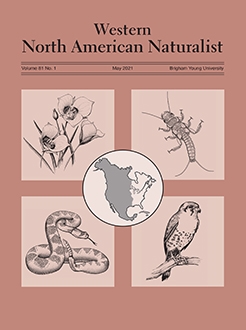Little information exists on the habitat use and feeding ecology of insectivorous bats in arid ecosystems, especially at and near uranium mines in northern Arizona, within the Grand Canyon watershed. In 2015–2016, we conducted mist-netting, nightly acoustic monitoring (>1 year), and diet analyses of bats, as well as insect sampling, at 2 uranium mines (Pinenut and Arizona 1) with water containment ponds. Because of physical barriers and limited general access to areas within the mine yard, mist-netting was limited to outside of the perimeter fence and away from the containment ponds. Mist-netting also occurred at 2 nearby sites that served as proxies to the mines. Bats captured directly at the mines included one pregnant Antrozous pallidus and 3 adult male Parastrellus hesperus. At the proxy sites, we captured 45 individuals identified as A. pallidus, Corynorhinus townsendii, Eptesicus fuscus, Euderma maculatum, Lasionycteris noctivagans, Myotis californicus, Myotis ciliolabrum, P. hesperus, and Tadarida brasiliensis. The nightly and seasonal presence of bats, as shown through acoustic recordings at each mine, coincided with the seasonal migratory and hibernation behaviors of the bat species. Statistical comparisons of acoustic recordings with precipitation data collected over one year show that seasonal monsoon rains generally had a negative effect on the nightly activity and presence of bats. Diets of P. hesperus from both mines were comprised mostly of coleopterans but also included smaller volumes of Hymenoptera, Hemiptera, Lepidoptera, Diptera, and Neuroptera. The diet of A. pallidus was comprised solely of Coleoptera. Diets of bat species from the proxy sites were characteristic of their known feeding ecology, which ranged from the consumption of soft-bodied insects (e.g., moths) by C. townsendii to the consumption of hard-bodied insects (e.g., beetles) by E. fuscus. Ultimately, the increased knowledge of the natural history of bats through multiple methods of data collection allows for a better understanding of complex arid ecosystems. It also provides resources needed for the management of habitat associated with alternative energy, such as uranium mining.
How to translate text using browser tools
11 May 2021
Seasonal Activity and Diets of Bats at Uranium Mines and Adjacent Areas near the Grand Canyon
Ernest W. Valdez,
Mollie K. Hanttula,
Jo Ellen Hinck
ACCESS THE FULL ARTICLE

Western North American Naturalist
Vol. 81 • No. 1
May 2021
Vol. 81 • No. 1
May 2021





